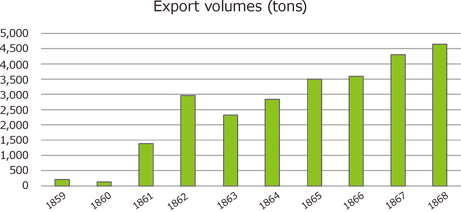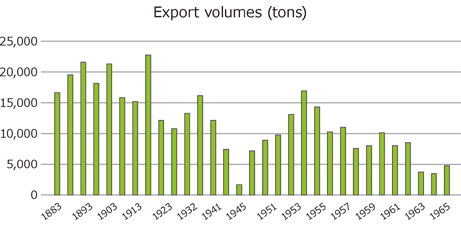History of Japanese tea export
In 1610, the Dutch East India Company imported tea through Hirado, and this was the very first time that Japanese tea was exported. After the arrival of Commodore Perry and the Black Ships, friendship and amenity treaties were signed with many nations and this had a significant impact on the export of tea. In 1859, 181 tons were shipped overseas, and by this time it was treated as an important export product. The revenues from the tea trade would in time also prove to be a valuable asset when funding Japan’s industrialisation. As illustrated in the diagram below, exports grew rapidly between 1859 and the beginning of the Meiji period (1868).

At the time, statistics of tea exports were not recorded by any governmental institution and during some periods, the export figures even exceed the recorded total production volume. Slightly odd figures aside, it is clear that great effort was made to send as much tea as possible overseas. The graph below depicts the export volumes between 1883 and 1965.

As the graph above shows, the export of tea decreased dramatically during World War II. However, tea was chosen as a return gift to the United States for the aid received after the war, and this put the tea production back on its wheels. During the best times of the post war era, as much as 15,000 tons were shipped overseas. This triggered the development of the tea industry, but the advance of Chinese tea and an appreciating yen caused Japanese tea to loose competitiveness on the international market, and this in combination with a growing domestic demand led to a rapid decrease in exports.
Issues for the export of Japanese tea
One of the great challenges for Japanese tea is of course to make sure that domestic demand recover. Here we can expect some results of the activities of Nihoncha Instructor Association, one of our member organisations. However, in order to increase demand, there is a need to face the following challenges regarding exports.
1. There is a need to raise the popularity of Japanese tea (unfortunately it is relatively unknown in many parts of the world)
2. The standards regarding trace levels of agricultural chemicals that are used in Japan does not apply in various countries that employ a positive list system.
3. The structure of domestic production is not developed to deal with these difficulties.
Japan Tea Export Council work actively to take on the above challenges and to create a more favourable environment for tea exports.







